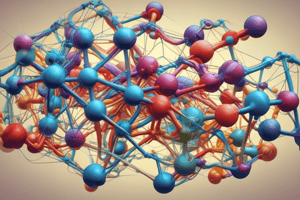Podcast
Questions and Answers
What is the primary goal of Quantitative Structure-Activity Relationships (QSAR)?
What is the primary goal of Quantitative Structure-Activity Relationships (QSAR)?
- To predict the biological activity of a compound
- To find the best compound in the most efficient manner possible (correct)
- To relate the biological activity of a series of compounds to their chemical properties
- To analyze the chemical properties of a compound
What type of measurements are required for QSAR?
What type of measurements are required for QSAR?
- Qualitative measurements for biological properties and quantitative measurements for physicochemical properties
- Quantitative measurements for biological and physicochemical properties (correct)
- Quantitative measurements for biological properties and qualitative measurements for physicochemical properties
- Qualitative measurements for biological and physicochemical properties
What is the significance of the partition coefficient (P) in QSAR?
What is the significance of the partition coefficient (P) in QSAR?
- It is a measure of the hydrophobicity of the molecule in octanol (correct)
- It relates the biological activity of a drug to its chemical structure
- It measures the hydrophobicity of the molecule in water
- It measures the electronic properties of substituents
What is the relationship between the activity of drugs and the partition coefficient (P)?
What is the relationship between the activity of drugs and the partition coefficient (P)?
What are the types of properties that are commonly studied in QSAR?
What are the types of properties that are commonly studied in QSAR?
What is the trend observed in the binding of drugs to serum albumin with respect to log P?
What is the trend observed in the binding of drugs to serum albumin with respect to log P?
What is the optimum value of log P for anaesthetic activity in different structural classes?
What is the optimum value of log P for anaesthetic activity in different structural classes?
What is the consequence of altering the log P value of drugs away from 2.0?
What is the consequence of altering the log P value of drugs away from 2.0?
What is the limitation of QSAR equations?
What is the limitation of QSAR equations?
What is the relationship between log P and the concentration of drug required to achieve a defined level of biological activity?
What is the relationship between log P and the concentration of drug required to achieve a defined level of biological activity?
Study Notes
Overview of QSAR
- QSAR stands for Quantitative Structure-Activity Relationship, aiming to derive equations that connect calculated properties of compounds with their biological activity.
- The primary goal of QSAR is to efficiently identify the best compounds for specific biological activities.
Essentials of QSAR
- Requires quantitative measurements for both biological and physicochemical properties to establish correlations.
- Mathematical formulas are utilized to relate the biological activity of compounds to their physicochemical parameters.
Key Physicochemical Properties
- Hydrophobicity of the molecule significantly influences biological activity.
- Hydrophobicity of substituents also plays a critical role.
- Electronic properties and steric properties of substituents must be considered in the analysis.
Commonly Studied Properties
- The partition coefficient (P) indicates hydrophobicity and is defined as the ratio of drug concentration in octanol to that in water.
- A high partition coefficient reflects high hydrophobicity, which often correlates with enhanced drug activity.
Binding Activity Insights
- Binding of drugs to serum albumin has a direct relationship with log P values, showing that binding increases with increasing log P.
- The equation Log (1/C) = 0.75 log P + 2.30 illustrates this relationship, where C is concentration for a defined biological effect (e.g., IC50).
General Anaesthetic Activity of Ethers
- A parabolic relationship is observed between log P values and general anaesthetic activity, indicating an optimal range for efficacy.
- The equation Log (1/C) = -0.22(log P)² + 1.04(log P) + 2.16 identifies an optimum log P value for anaesthetic activity.
Structural Class Specificity
- QSAR equations are only applicable within the same structural class of compounds (e.g., ethers).
- Despite different structural classes, a similar log Po value (approximately 2.3) exists for many anaesthetics, facilitating CNS penetration.
CNS Penetration
- Compounds with a log P around 2.3 can easily enter the central nervous system, exemplified by potent barbiturates, which have a log P near 2.0.
- Adjusting the log P value away from 2.0 may help to avoid central nervous system side effects in drug formulations.
Studying That Suits You
Use AI to generate personalized quizzes and flashcards to suit your learning preferences.
Related Documents
Description
This quiz covers the concept of QSAR, which involves relating biological activity to physicochemical parameters using mathematical formulas. Learn how to predict biological activity and find the best compounds efficiently. Understand the requirements and goals of QSAR.




